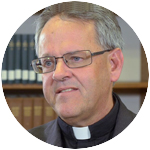
Father Thomas Dailey, O.S.F.S.
The light at the end of the pandemic’s tunnel is getting brighter. The Archdiocese of Philadelphia recently announced the easing of COVID restrictions for parish churches. Concomitantly, it launched a new initiative – “Nothing compares to being there” – to encourage the return of the faithful to in-person worship.
Being unmasked does more than make a visage visible. It facilitates a fuller communication by enabling the whole person to “speak” even without words. It makes possible a deeper sight of the other person, in the very uniqueness that their face reveals. It enables an encounter with others as they are.
That experience lies at the heart of Pope Francis’s message for this year’s World Communications Day (celebrated on the Sunday before Pentecost). Entitled “Come and See,” the message highlights the importance of face-to-face communication.
The Holy Father points out what we all know from experience, an experience that has been somewhat impeded by having to wear masks. “Some things can only be learned through first-hand experience,” he writes, because “we do not communicate merely with words, but with our eyes, the tone of our voice and our gestures.”
[hotblock]
More than a sociological statement, this truth of communications points also to the distinctiveness of Christian faith. St. John writes of this in one of his letters. “No one has ever seen God,” he admits. But then he makes a unique claim: “we have seen and testify that the Father sent his Son as savior of the world” (1 John 4:11, 14). Not only that, the Apostles also saw Jesus raised from the dead and watched as he ascended to heaven.
As Pope Francis explains, “Jesus’ attractiveness to those who met him depended on the truth of his preaching; yet the effectiveness of what he said was inseparable from how he looked at others, from how he acted towards them, and even from his silence. The disciples not only listened to his words; they watched him speak.”
Those sights and sights remain the foundation of our faith. They draw us to a God who is real, the God who is also a person, the God whom we are invited to encounter. “Indeed,” says Pope Francis, “in him – the incarnate Logos – the Word took on a face; the invisible God let himself be seen, heard and touched.”
Now, as then, faces speak, which is why being able to see them again makes us so elated. So, too, when we are unmasked, we will have the opportunity to let others see our faces – and, potentially, the joy of the Spirit that shines forth from them.
That joy, and the happiness of seeing smiles, is what enthuses us about no longer having to wear masks. It’s also a reminder of what makes evangelizing really effective – the conviction of our own faith made evident in the joy of knowing the Good News of salvation.
As Pope Francis puts it in the conclusion to his message: “the Gospel comes alive in our own day, whenever we accept the compelling witness of people whose lives have been changed by their encounter with Jesus. For two millennia, a chain of such encounters has communicated the attractiveness of the Christian adventure. The challenge that awaits us, then, is to communicate by encountering people, where they are and as they are.”
That witness can and has been communicated through various forms of social media – which parishes would be wise to carry on purposefully as a means of reaching out to and building up the faith community beyond the walls of a church.
But an unparalleled experience of that Gospel encounter happens in the celebration of the Mass – where our lives are renovated and renewed by directly hearing the sacred Word and tangibly receiving the Blessed Sacrament.
The event of our redemption celebrated on Sundays remains the foundation of our faith. It follows, undeniably, that an unmediated celebration of that event remains our fullest way of encountering the Lord Jesus.
But simply being there, even in-person and unmasked, will not suffice. To re-engage the faithful, we need to consider what it is that parishioners will “come and see” when they return to worship in parish churches? What have we learned from this time apart that we need to do differently and do better in order for our liturgical celebrations to communicate the attractiveness of the Christian adventure?
With the outpouring of the Holy Spirit this Pentecost, may our unmasked faces once again radiate the joy of the faith we have in God and share with one another.
* * *
Father Thomas Dailey, O.S.F.S., is the John Cardinal Foley Chair of Homiletics and Social Communications at St. Charles Borromeo Seminary, Wynnewood.
Commemorating World Communications Day, the seminary will host the annual John Cardinal Foley Symposium on May 27 at 7 p.m. This year’s featured guest is John Quiñones from ABC News. Online participation in the panel discussion and award presentation is welcome. Further information can be found at http://www.scs.edu/cardinal-foley-symposium.
PREVIOUS: Join the Philadelphia Serra Club and ensure future of our church
NEXT: Making sense of the Communion debate



Share this story